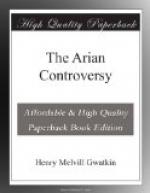[Sidenote: (2.) In the East.]
If the Sirmian manifesto disturbed the West, it spread dismay through the ranks of the Eastern conservatives. Plain men were weary of the strife, and only the fishers in troubled waters wanted more of it. Now that Marcellus and Photinus had been expelled, the Easterns looked for rest. But the Sirmian manifesto opened an abyss at their feet. The fruits of their hard-won victories over Sabellianism were falling to the Anomoeans. They must even defend themselves, for Ursacius and Valens had the Emperor’s ear. As if to bring the danger nearer home to them, Eudoxius the new bishop of Antioch, and Acacius of Caesarea convened a Syrian synod, and sent a letter of thanks to the authors of the manifesto.
[Sidenote: Synod of Ancyra (Lent, 358).]
Next spring came the conservative reply from a knot of twelve bishops who had met to consecrate a new church for Basil of Ancyra. But its weight was far beyond its numbers. Basil’s name stood high for learning, and he more than any man could sway the vacillating Emperor. Eustathius of Sebastia was another man of mark. His ascetic eccentricities, long ago condemned by the council of Gangra, were by this time forgotten or considered harmless. Above all, the synod represented most of the Eastern bishops. Pontus indeed was devoted to conservatism, and the decided Arianizers were hardly more than a busy clique even in Asia and Syria. Its decisions show the awkwardness to be expected from men who have had to make a sudden change of front, and exhibit well the transition from Eusebian to Semiarian conservatism. They seem to start from the declaration of the Lucianic creed, that the Lord’s sonship is not an idle name. Now if we reject materialising views of the Divine Sonship, its primary meaning will be found to lie in similarity of essence. On this ground the Sirmian manifesto is condemned. Then follow eighteen anathemas, alternately aimed at Aetius and Marcellus. The last of these condemns the Nicene of one essence—clearly as Sabellian, though no reason is given.
[Sidenote: Victory of the Semiarians.]
The synod broke up. Basil and Eustathius went to lay its decisions before the court at Sirmium. To conciliate the Nicenes, they left out the last six anathemas of Ancyra. They were just in time to prevent Constantius from declaring for Eudoxius and the Anomoeans. Peace was made before long on Semiarian terms. A collection was made of the decisions against Photinus and Paul of Samosata, together with the Lucianic creed, and signed by Liberius of Rome, by Ursacius and Valens, and by all the Easterns present. Liberius had not borne exile well. He had already signed some still more compromising document, and is denounced for it as an apostate by Hilary and others. However, he was now allowed to return to his see.
[Sidenote: The Semiarian failure.]
The Semiarians had won a complete victory. Their next step was to throw it away. The Anomoean leaders were sent into exile. After all, these Easterns only wanted to replace one tyranny by another. The exiles were soon recalled, and the strife began again with more bitterness than ever.




